Related Research Articles

David Gallaher was an Irish-born New Zealand rugby union footballer best remembered as the captain of the "Original All Blacks"—the 1905–06 New Zealand national team, the first representative New Zealand side to tour the British Isles. Under Gallaher's leadership the Originals won 34 out of 35 matches over the course of tour, including legs in France and North America; the New Zealanders scored 976 points and conceded only 59. Before returning home he co-wrote the classic rugby text The Complete Rugby Footballer with his vice-captain Billy Stead. Gallaher retired as a player after the 1905–06 tour and took up coaching and selecting; he was a selector for both Auckland and New Zealand for most of the following decade.
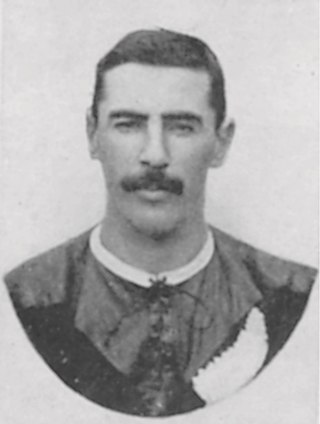
George Arthur Gillett was a New Zealand multi-code footballer of the early 20th century and a dual-code rugby international. Gillett died in 1956 in Onehunga.
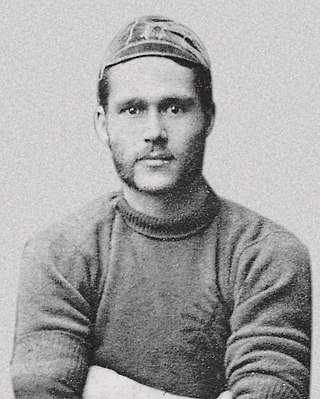
Joseph Astbury Warbrick was a Māori rugby union player who represented New Zealand on their 1884 tour to Australia and later captained the 1888–89 New Zealand Native football team that embarked on a 107-match tour of New Zealand, Australia, and the British Isles.

George Carter was one of New Zealand's first-ever rugby union representatives, playing for the All Blacks. Representing New Zealand in 7 Matches in 1884. Carter won praise from team manager Samuel Sleigh who wrote: "No amount of knocking seemed to have the slightest effect on this hard-working forward." He came into the New Zealand team for the Australian tour after Bob Whiteside and then Frank Clayton withdrew.
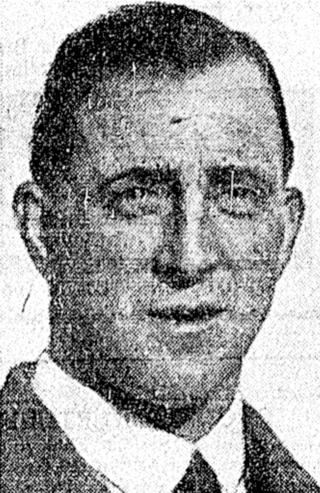
Karl Donald Ifwersen (1893–1967) was a New Zealand rugby football player who represented New Zealand in both rugby league and rugby union.
Alwin John "Dougie" McGregor (1889–1963) was a dual-code rugby footballer who represented New Zealand in both rugby union and rugby league.
Hugh Maurice Good was a New Zealand rugby union player who was a member of the New Zealand national team in 1894. His position of choice was wing three-quarter. Good did not play any test matches as New Zealand did not play their first until 1903.
The 1911 Auckland Rugby League season was the second full organised club season in Auckland following the 1910 Auckland Rugby League season. City Rovers won the title again after winning it in the competitions inaugural year.
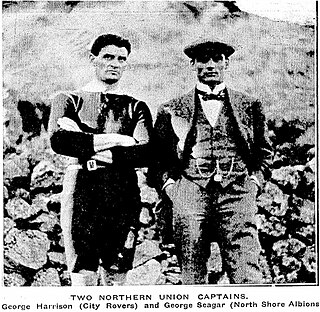
The 1912 Auckland Rugby League season was the 4th official year of the Auckland Rugby League. The season commenced on 11 May, with the start of the First Grade competition.
The 1913 Auckland Rugby League season was the 5th season of the Auckland Rugby league.
The 1914 season was the sixth season of Auckland Rugby League since its formation in 1909. It followed the 1913 Auckland Rugby League season where North Shore Albions were crowned senior champions for the first time. The senior grade saw the addition of Otahuhu Rovers, who had previously competed in the lower grades only, and Grafton Athletic. The Manukau Rovers and Eden Ramblers no longer contributed teams. The first grade was won once again by North Shore Albions.
The 1917 Auckland Rugby League season was its 9th. Due to the large number of players now serving in the First World War it was agreed to relax transfer rules to allow players from stronger teams to join weaker teams to even the competition. It was noted how many men from various clubs had been killed in battle by the beginning of 1917. They were Cecil Walker, Doug Dawson, T Marshall, Charles Savory, Frank McWhirter, Graham Cook, N Vause, Victor McCollum, Alf Gault, T Lambert, E Tiernan, F Stubbs, W. G. Handle, B Hart, Frederick Gladding, A Powley, Chas Mann, William Moeki, G Jones, W Harris, Sam Magee, S Greer, Alan Miller, Charles Sinton, and Leslie O'Leary (Sunnyside). City Rovers had 'sent' ninety men to war by this time and twenty-one had been wounded and five killed. The Sunnyside club had only nine members left and one of those who had gone to the war said that in the trenches he had made a list of league players from various clubs which totaled 120. All three of the Sunnyside secretaries had enlisted and the executive was also gone. Ponsonby had also had over eighty of its members join the war effort.
The 1919 season of the Auckland Rugby League was its 11th. It was the first season post World War I and unsurprisingly it saw a resurgence in playing numbers with 56 teams across the six grades. North Shore Albions who had previously dropped out of the senior competition again fielded a senior side. As did Otahuhu, who had dropped out during the 1917 season. Ponsonby United won their third consecutive first grade title, while Newton Rangers won the Roope Rooster trophy.
The 1921 season of Auckland Rugby League was its 13th. Seventy two teams played across its six main grades.
Ivan Stewart (1894–1952) played for the New Zealand rugby league team. He was Kiwi number 119 and played one test, against Australia in 1919. He played for the North Shore Albions after returning from the war in 1917, and then for City Rovers in the Auckland Rugby League competition from 1918 to 1920.
William George Walsh was a New Zealand rugby league player. He first played for New Zealand in 1919 on the tour of Australia and became Kiwi number 122. He ended with 8 matches for New Zealand in total playing one test against Australia. He played his entire club career with the Ponsonby United club in the Auckland Rugby League.
George Paki was a New Zealand international rugby league player. He debuted for New Zealand in 1921 and became Kiwi number 151 in the process. He also played for New Zealand Māori rugby league team and an unofficial New Zealand Māori rugby side which toured Australia and New Zealand in 1913.
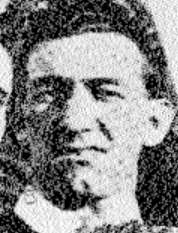
Hector Stanley Esmond Cole was a New Zealand rugby league player who played for the New Zealand in 1926 and 1927. He made 14 appearances for them and was Kiwi number 183. He also played several times for Auckland and represented the Ponsonby United club from 1922 to 1929.
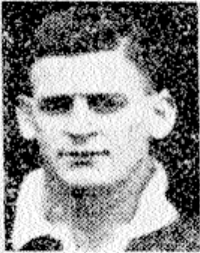
Allan (Lar) Wilfred Seagar was a rugby league player who represented New Zealand in 1930, thus becoming New Zealand's 212th player. He also played for Auckland in 13 matches, and played from 1923 to 1941 for Devonport United, playing 159 matches. His brother George Seagar also represented New Zealand at rugby league; while his son Allan Herbert Seagar was a New Zealand champion swimmer, representing New Zealand at the 1962 and 1966 Commonwealth Games.
Edward Joseph Bennett was a New Zealand rugby league footballer. Bennett played in the second row position. He represented the New Zealand rugby league team in two test matches against England in 1920. In the process he became the 144th player to represent New Zealand. He also played for the Waiuku rugby club, and the Newton Rangers, and Grafton Athletic rugby league clubs. Bennett also represented the Auckland and North Island rugby league teams.